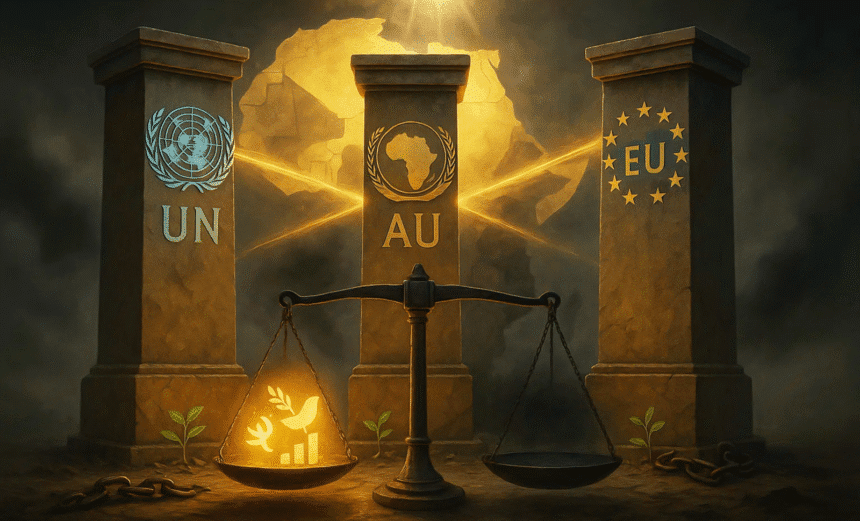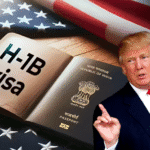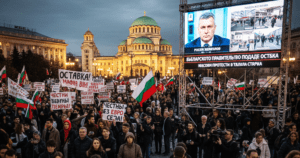Leaders from the United Nations, African Union, and European Union have recently reaffirmed their commitment to a joint strategy to advance peace and development across Africa. While this development may seem familiar in rhetoric, the current geopolitical, economic, and institutional pressures make its implications deeper, and its prospects more critical than past pledges.
Political Landscape and Strategic Drivers
The renewed pledge emerges at a moment when Africa is confronting multiple overlapping crises: civil unrest in the Sahel, war in Sudan, instability in eastern Democratic Republic of Congo, and rising foreign influence, including through disinformation campaigns. The EU‑AU ministerial meeting in Brussels in May 2025 underscored concerns about “foreign malign influence” and misinformation, with EU foreign policy chief Kaja Kallas warning that such challenges are deeply undermining regional stability.
These concerns are not isolated. Institutional relationships are shifting: African states in the Sahel are recalibrating alliances; transnational threats like climate change, supply chain fragility, and pandemics demand collective action; and the UN’s role as mediator and coordinator is being increasingly looked upon to strengthen frameworks for peace that are African led and globally supported. The Joint Vision for 2030 adopted in 2022 between AU and EU is central to this context.
Concrete Pledges vs Implementation Gaps
The declarations contain significant items: commitments to strengthen peace, security, and governance; boosting economic integration; expanding investment in infrastructure, education, health, and climate resilience; improving multilateral cooperation; enhancing domestic resource mobilization; and tackling corruption and illicit financial flows. For example, the Africa Facility to Support Inclusive Transitions (AFSIT), jointly backed by the UNDP and African Union, recently secured US$1 million from the EU to support data tools that help governments navigate transitions and strengthen institutions.
Yet, historically, frameworks of this sort often struggle in translating between high‑level pledges and national realities. One major challenge is capacity: many countries lack sufficient institutional strength, stable funding, or political consensus to bridge those gaps. Another is coordination: given the multiplicity of actors (national governments, regional mechanisms, NGOs, private sector), aligning priorities and avoiding duplication is difficult. Third, measuring success requires reliable data and accountability mechanisms, which are often weak, especially under conflict settings or fragile states.
Implications For Development, Governance and Regional Order
If well implemented, the tripartite pledge could shift patterns of development in Africa. First, promoting African ownership of peace processes could help in making solutions more sustainable. The insistence by EU and AU that peace efforts must be “African led and African owned” indicates recognition of past failures where external interventions lacked sustained local anchoring.
Second, investment strategies tied to the Global Gateway Africa‑Europe Investment Package and Agenda 2063 may enable more equitable infrastructure growth, digital connectivity, and green transition. These are key to closing not only physical divides but also opportunity gaps, especially for youth and rural populations.
Third, governance and legitimacy could see an upturn if transparency, multilateral norms, and rules‑based frameworks are reinforced. Combating illicit financial flows amounting to some tens of billions of dollars annually and strengthening domestic resource mobilization are central to making states more self‑reliant and accountable.
Risks and What Success Will Require
The pledge is not without risks. If peace processes fail to resolve root causes, ethnic grievances, competition over resources, climate stress, or if security strategies ignore human rights, then unrest may deepen. Corruption, fragile institutions, external powers pushing their agendas, and blunt force security solutions could undermine development goals. In addition, if funding is inconsistent, or subject to political conditionality detached from local contexts, promises may degrade into bureaucratic tokenism.
Success will require several key enabling conditions. Strong regional bodies capable of mediation and early warning (for example, within AU structures) are essential. Transparent monitoring and independent evaluation must be built into projects from the start. Financing must be not just generous but predictable and aligned with recipient country priorities. And finally, civil society and community participation must be integral to both peace and development initiatives so that legitimacy is rooted in the people affected.
Looking Ahead: Opportunities for Africa
This moment offers a chance for Africa to reset its trajectory. With strategic backing from UN, EU, and AU, there is potential to build resilient systems rather than ad hoc fixes. If growth is inclusive, security durable, governance accountable, and partnerships equitable, the continent may achieve more than incremental gains. Rather than merely responding to crises, African nations could lead global innovations in peacebuilding, green transitions, digital governance, and financial inclusion.
A Final Note
The joint pledge by UN, AU, and EU leaders is more than diplomacy it can become a transformative framework, if the gap between promise and practice is bridged. The real test lies in how well African states, regional institutions, and international partners can translate shared vision into durable peace, fair governance, and sustainable development. The stakes are high and the possibilities real.
















